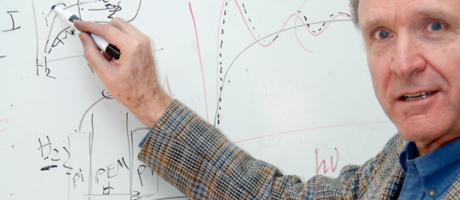In his 2003 State of the Union address, former President George W. Bush proposed $1.2 billion in funding for research developing hydrogen-powered cars. “A simple chemical reaction between hydrogen and oxygen generates energy, which can be used to power a car, producing only water, not exhaust fumes,” he said.
President Bush was referring to fuel cells, which generate energy by converting fuels like hydrogen, oxygen or alcohols, and which are already being used to power many prototype cars.
New research from David Ramaker, professor of chemistry, which is funded by the Department of Energy, allows scientists to see aspects of fuel cells that have never been observed before.
“This new information is now enabling us to understand why some catalysts, the heart of the fuel cell, work better than others, why some get poisoned more than others and why some age and deteriorate more than others,” says Dr. Ramaker. A catalyst is a substance such as platinum metal that speeds up a chemical reaction.
According to Dr. Ramaker, a hydrogen fuel cell can run an automobile motor and produce only water as the exhaust from the tailpipe. “Even if gasoline was reformed to produce the hydrogen, the car could still operate at twice the fuel efficiency of current internal combustion engines, saving gasoline,” he says.
The study, of which Dr. Ramaker is co-principal investigator with colleagues from five other institutions, focuses on using something called X-ray absorption spectroscopy (XAS) to study absorption of small molecules on catalysts during fuel cell operation.
The technique measures the amount of light an object, like a metal catalyst, absorbs by using an intense X-ray beam coming from a synchrotron, or a device that uses electromagnetic fields to accelerate particles around a large ring that then radiates x-rays.
X-ray absorption spectroscopy can be used to obtain not only catalyst structural information but also to determine how and where the small molecules bind to the catalysts.
Dr. Ramaker and his research group have developed a new XAS data analysis approach, which allows them to determine the atomic and molecular absorption sites on small metal nano-particles. “The techniques can be applied to very complex systems,” he says.
The Department of Energy award is the second Energy Frontier Research Centers - Department of Energy consortium award won by the Department of Chemistry and the third from stimulus funds. Christopher Cahill, associate professor of chemistry, won a $1.2 million Department of Energy award last fall and Cindy Dowd, assistant professor of chemistry, received NIH funding for a project last winter.
“Our department, which is relatively small for chemistry departments, now has its third stimulus package grant,” says Michael King, chair of the department. “This is an amazing accomplishment for us and for GW.”


